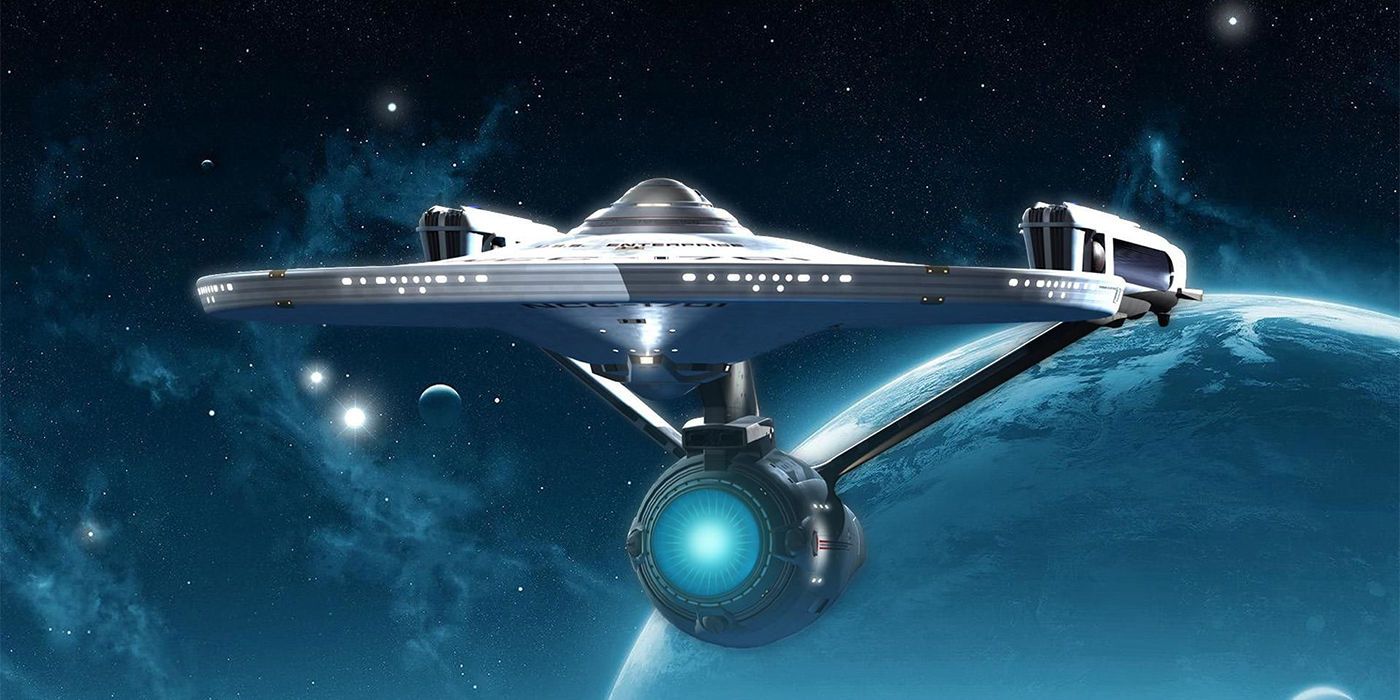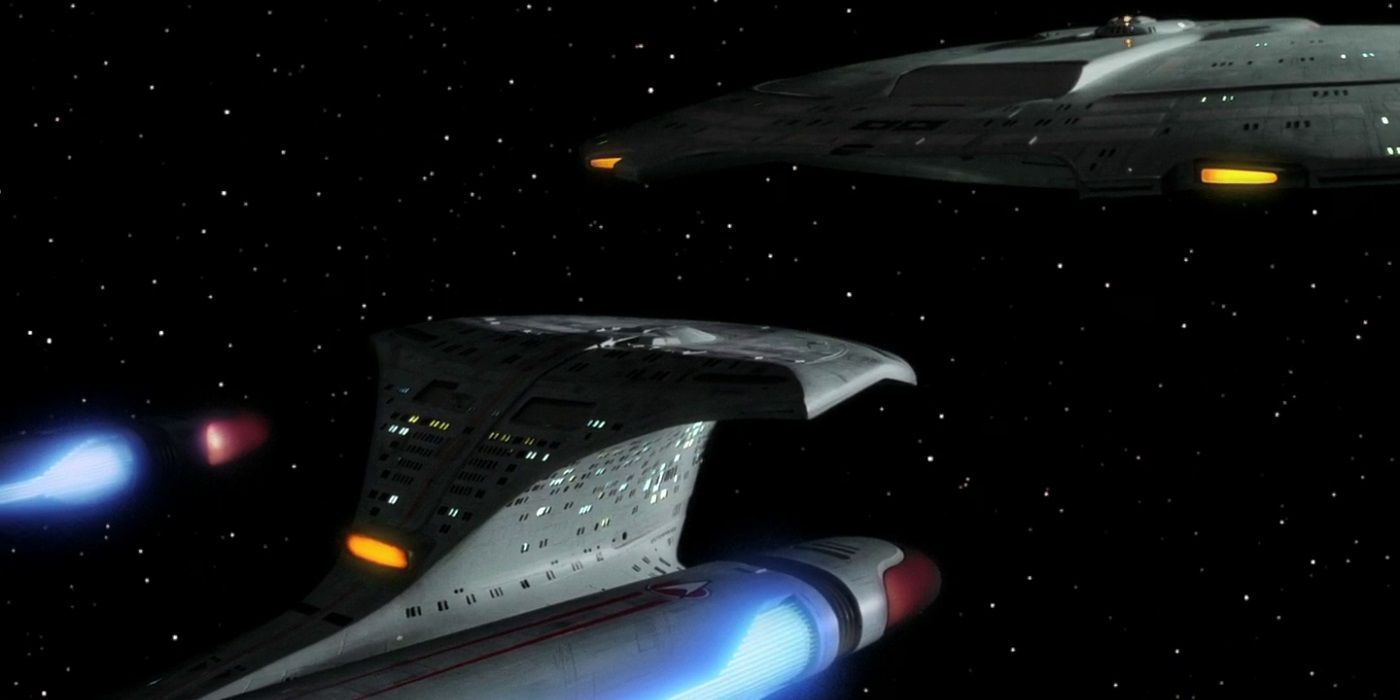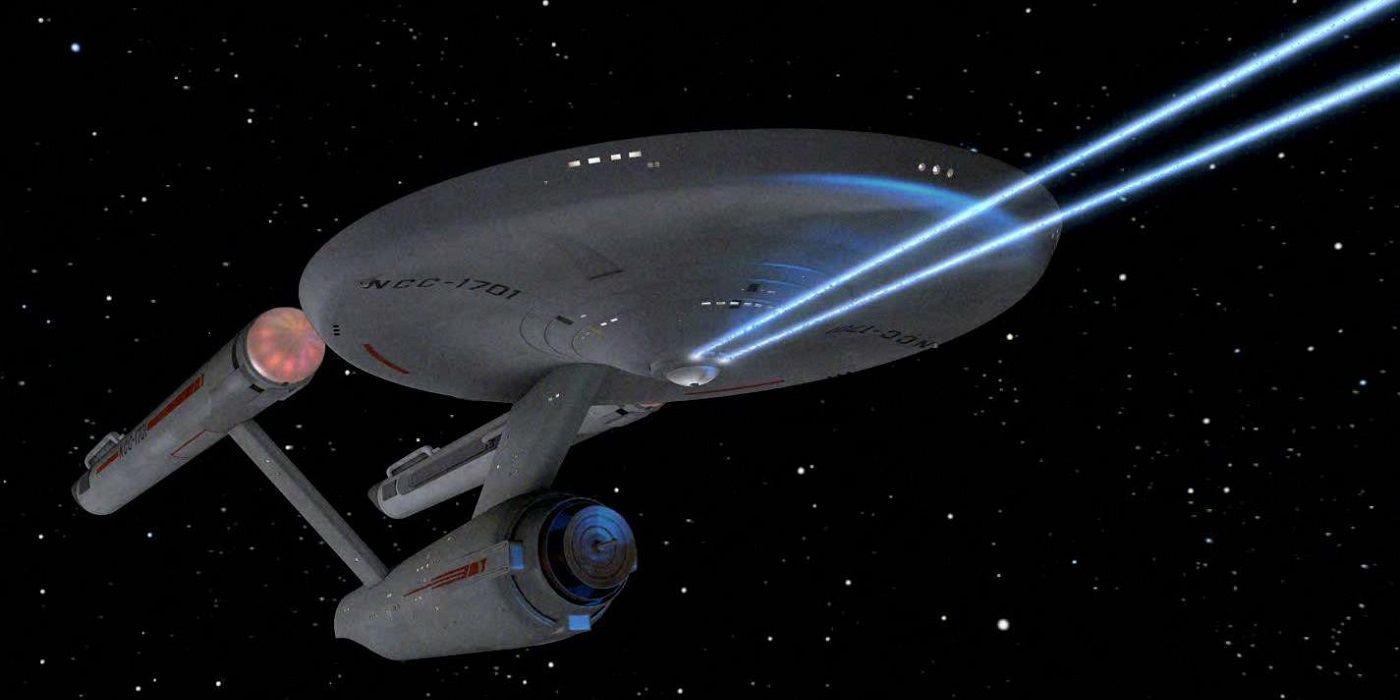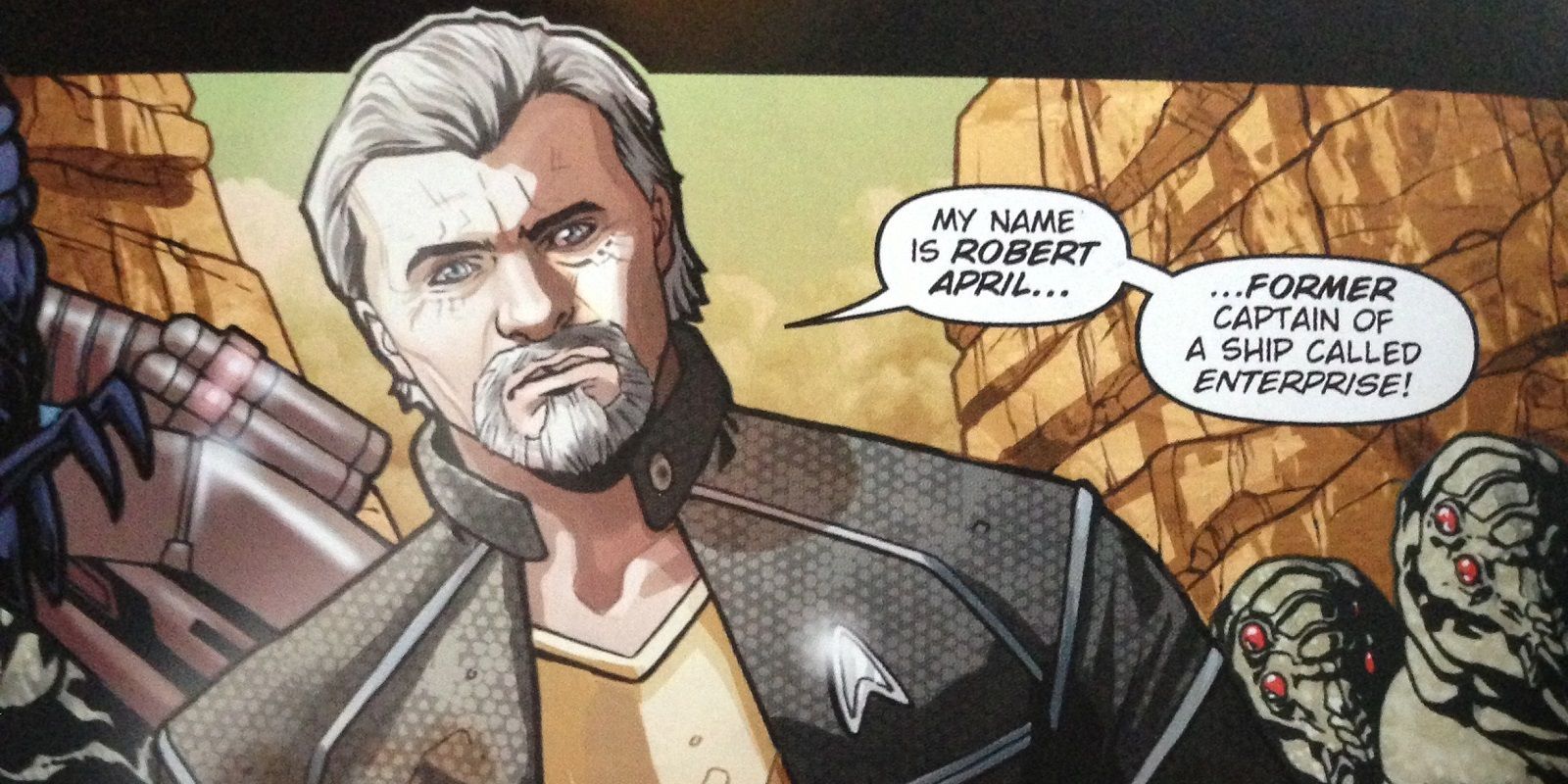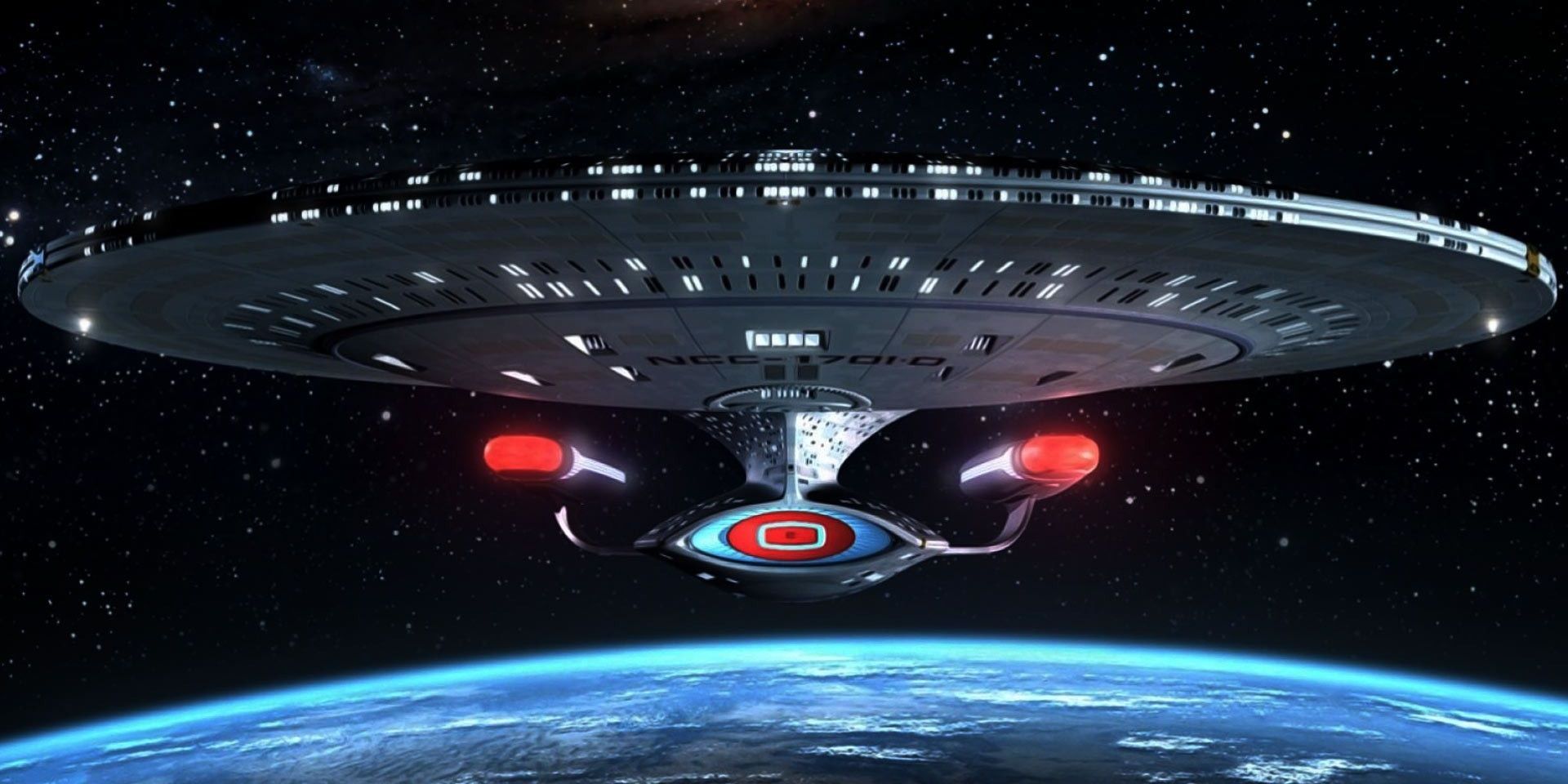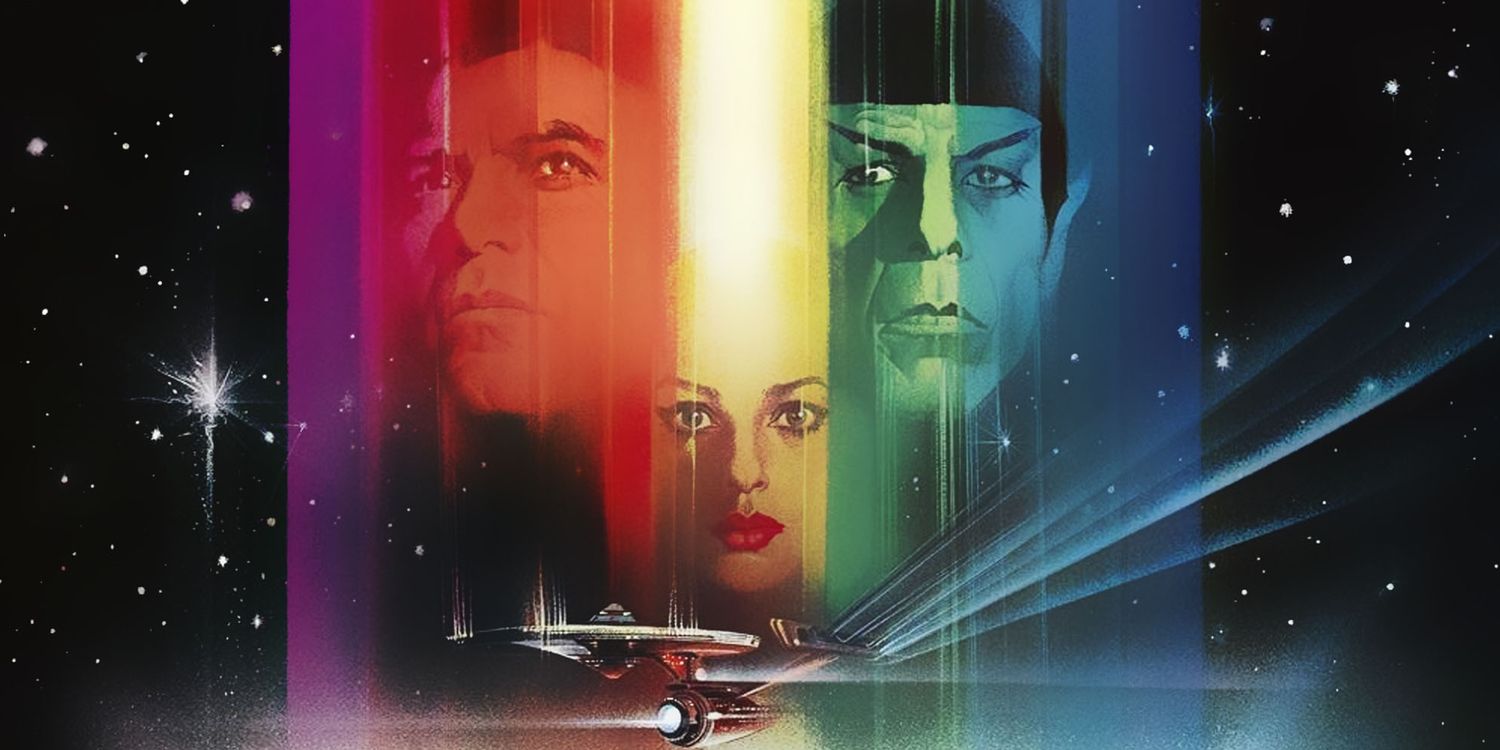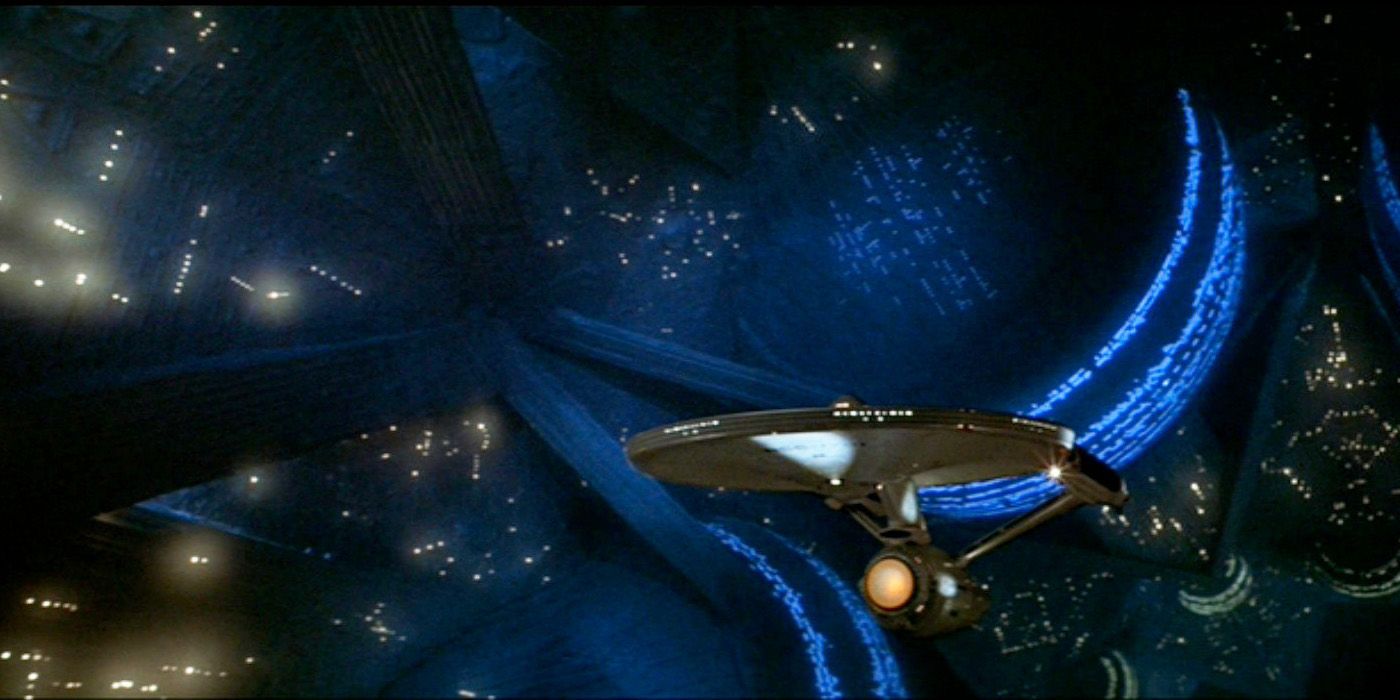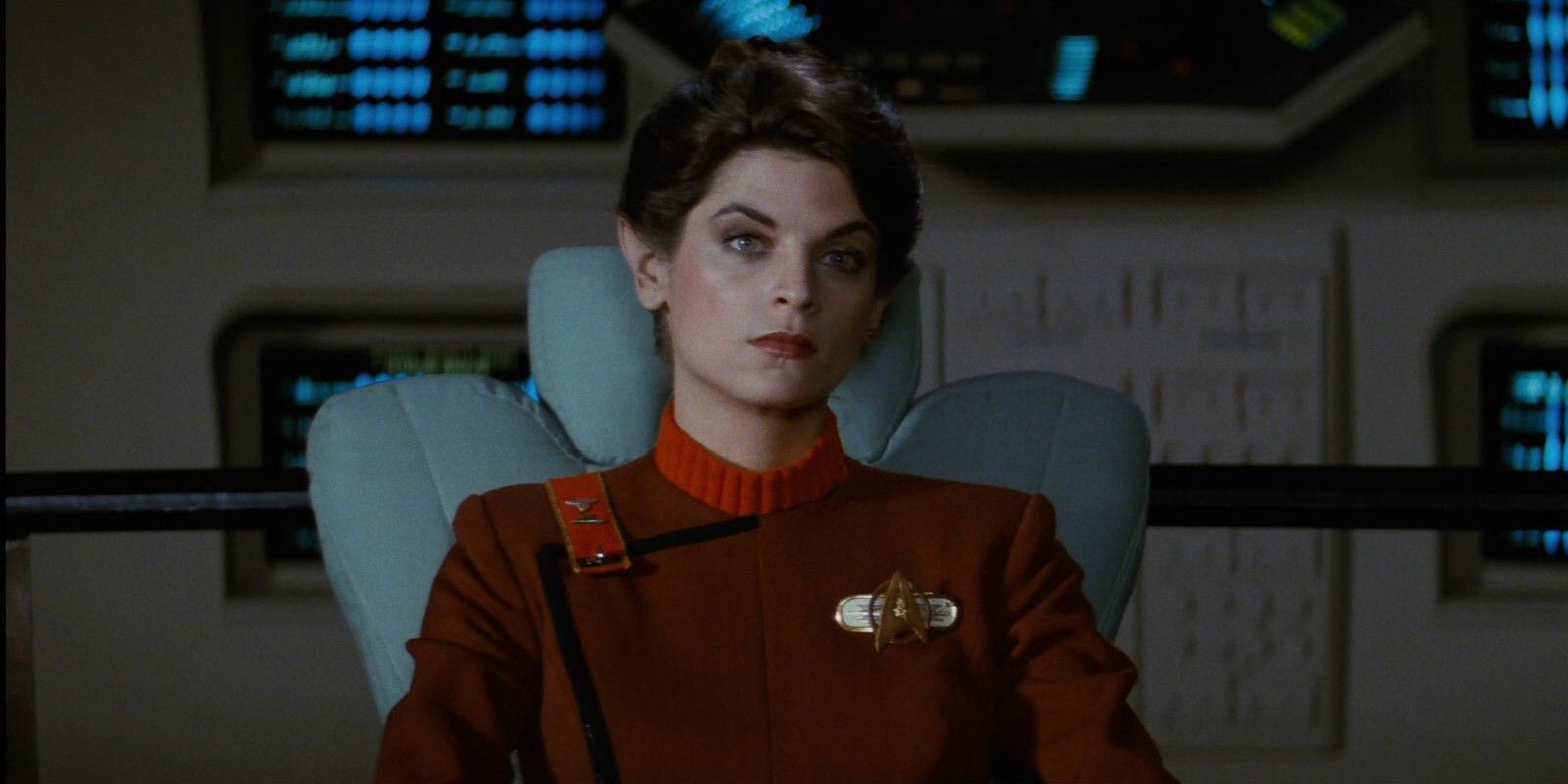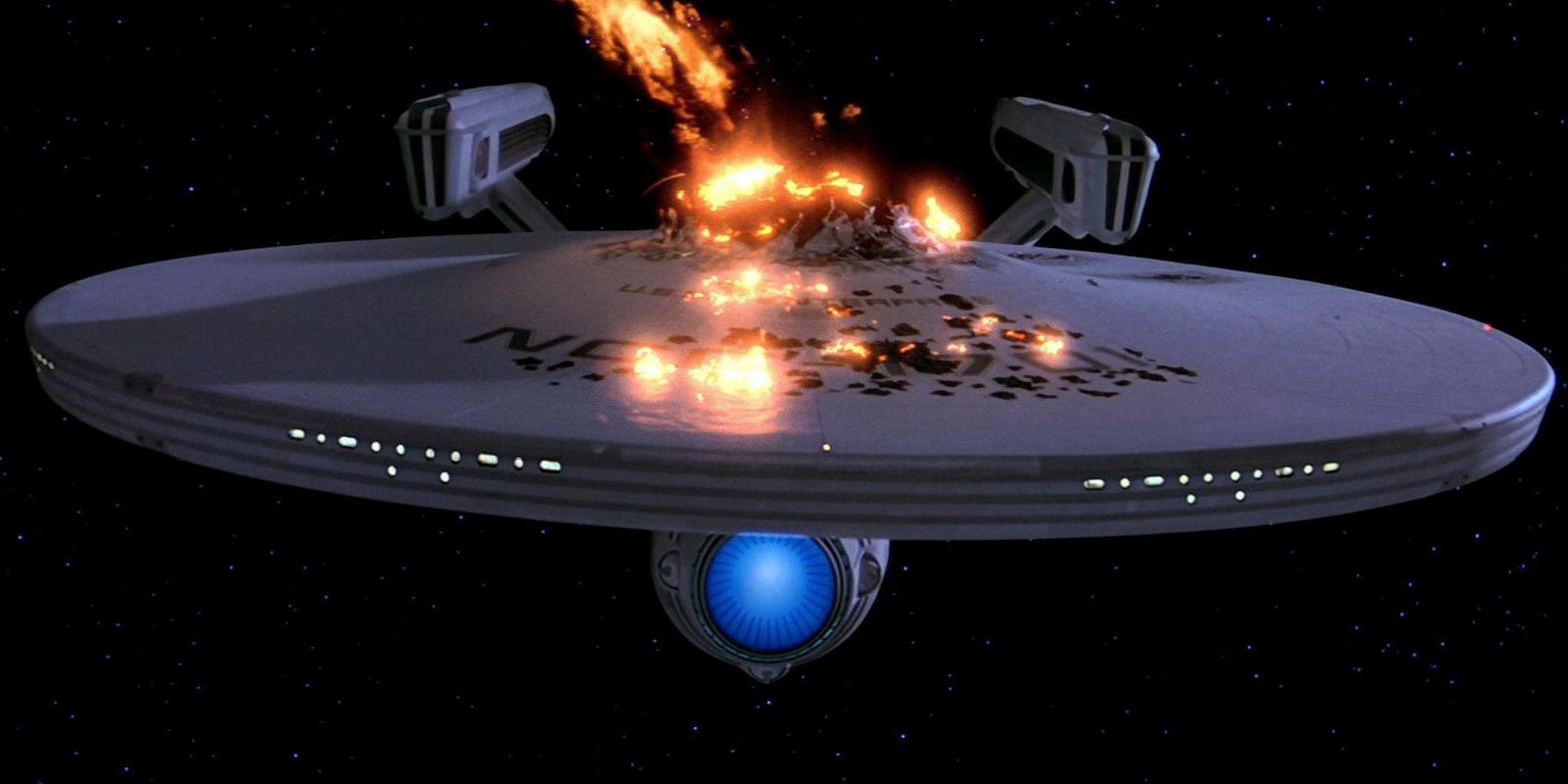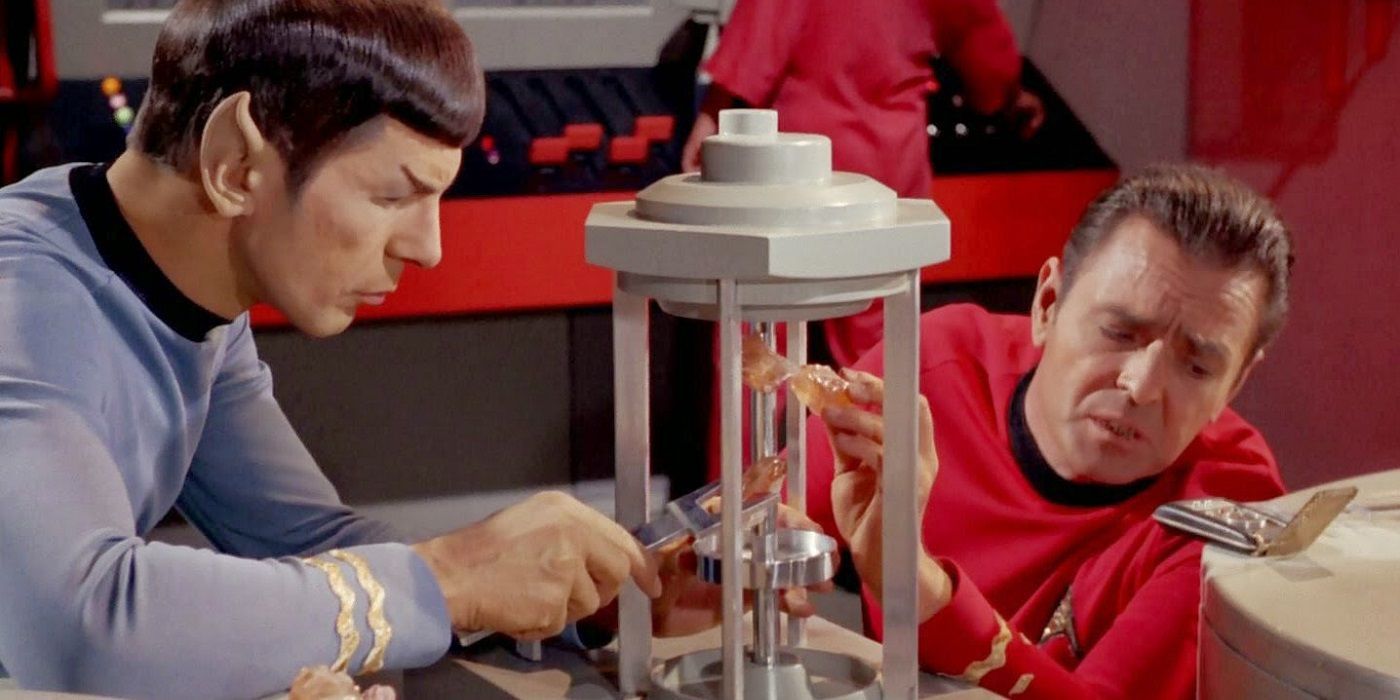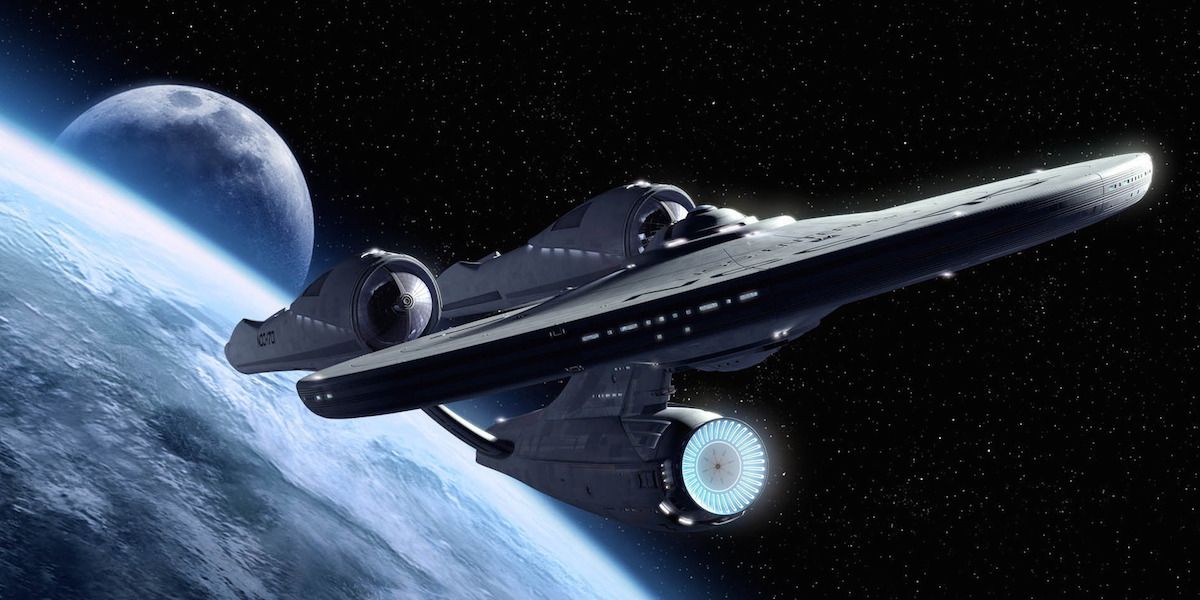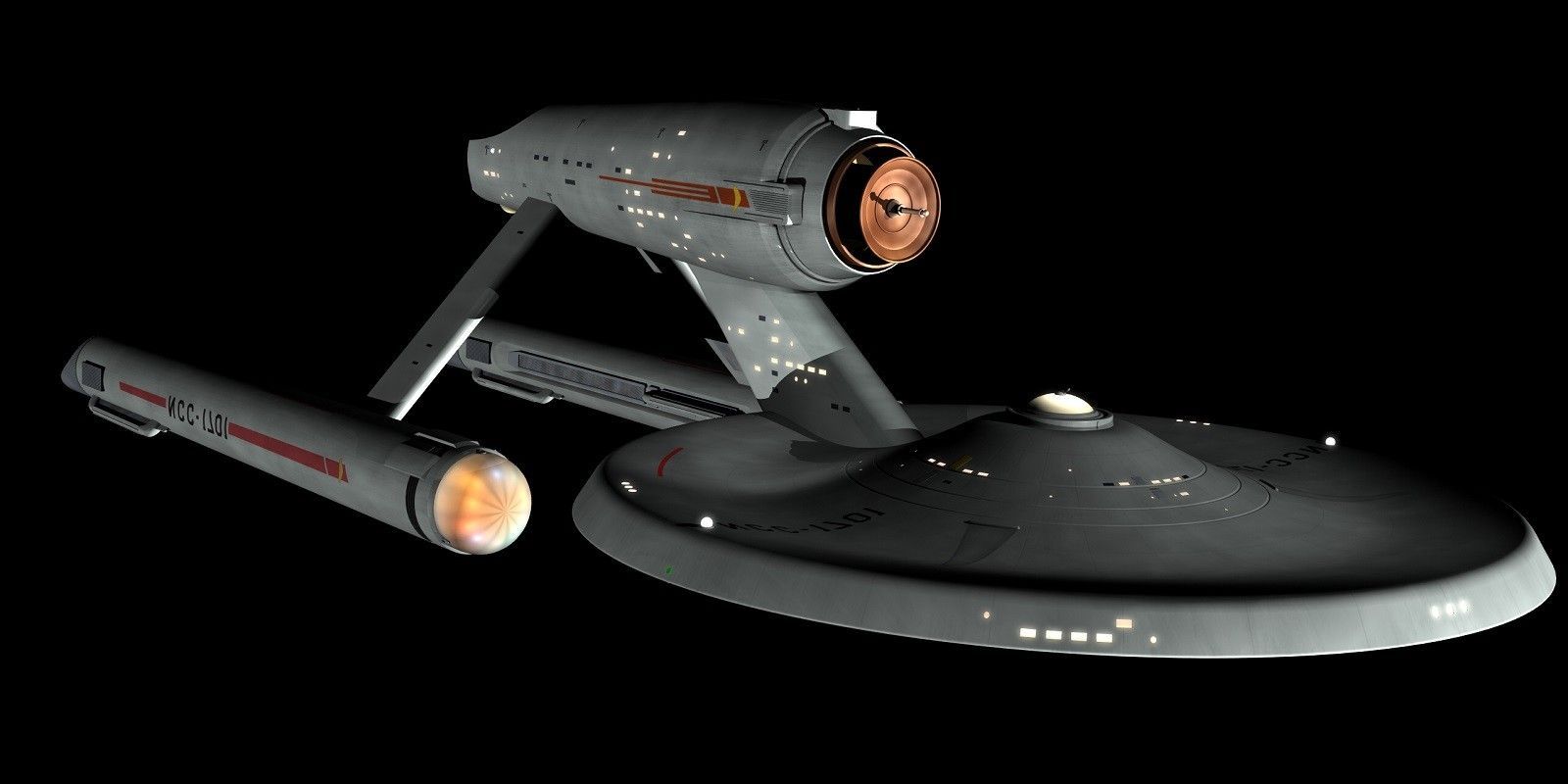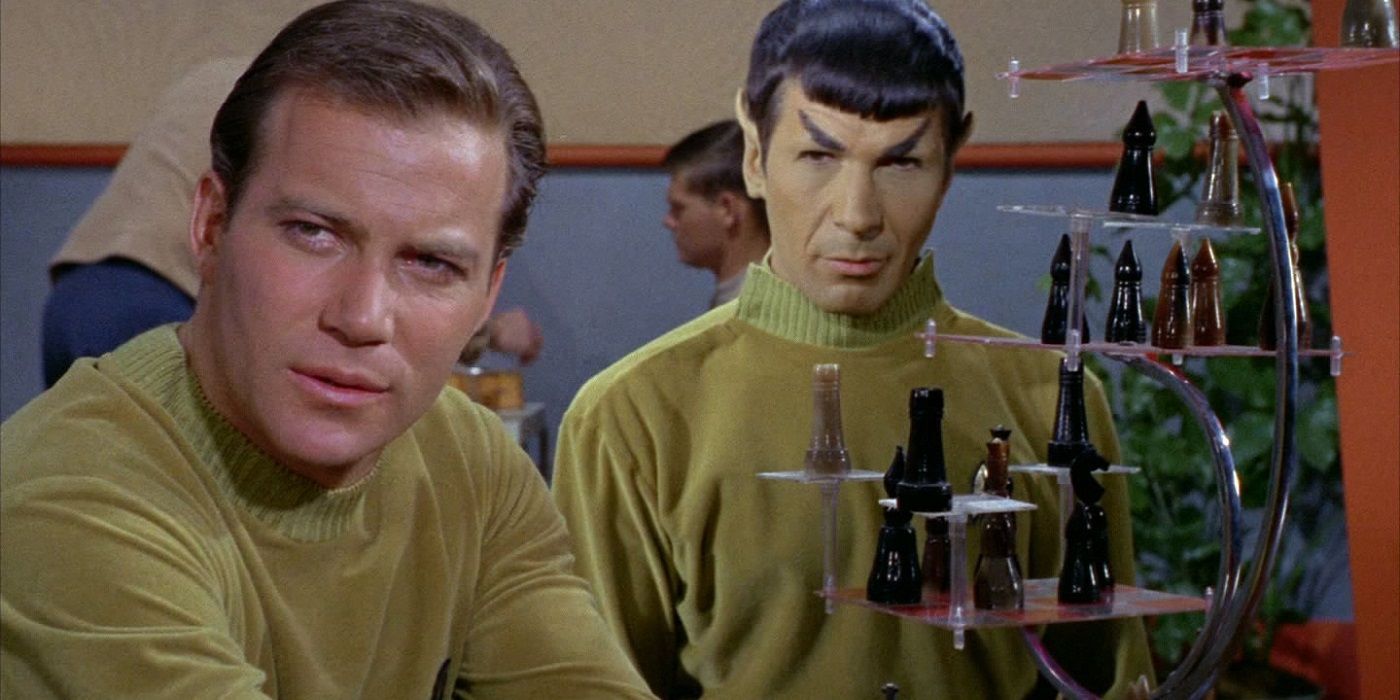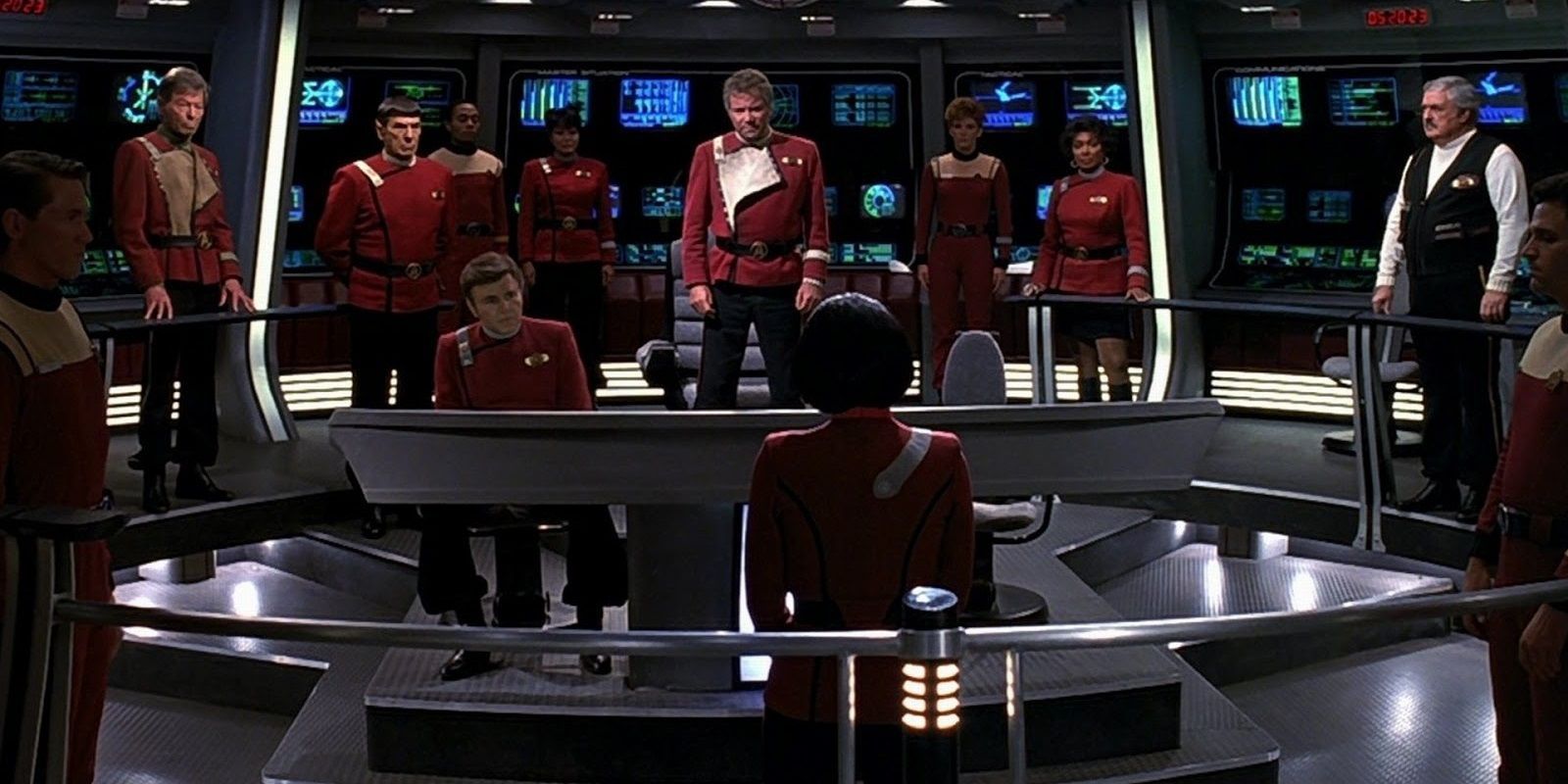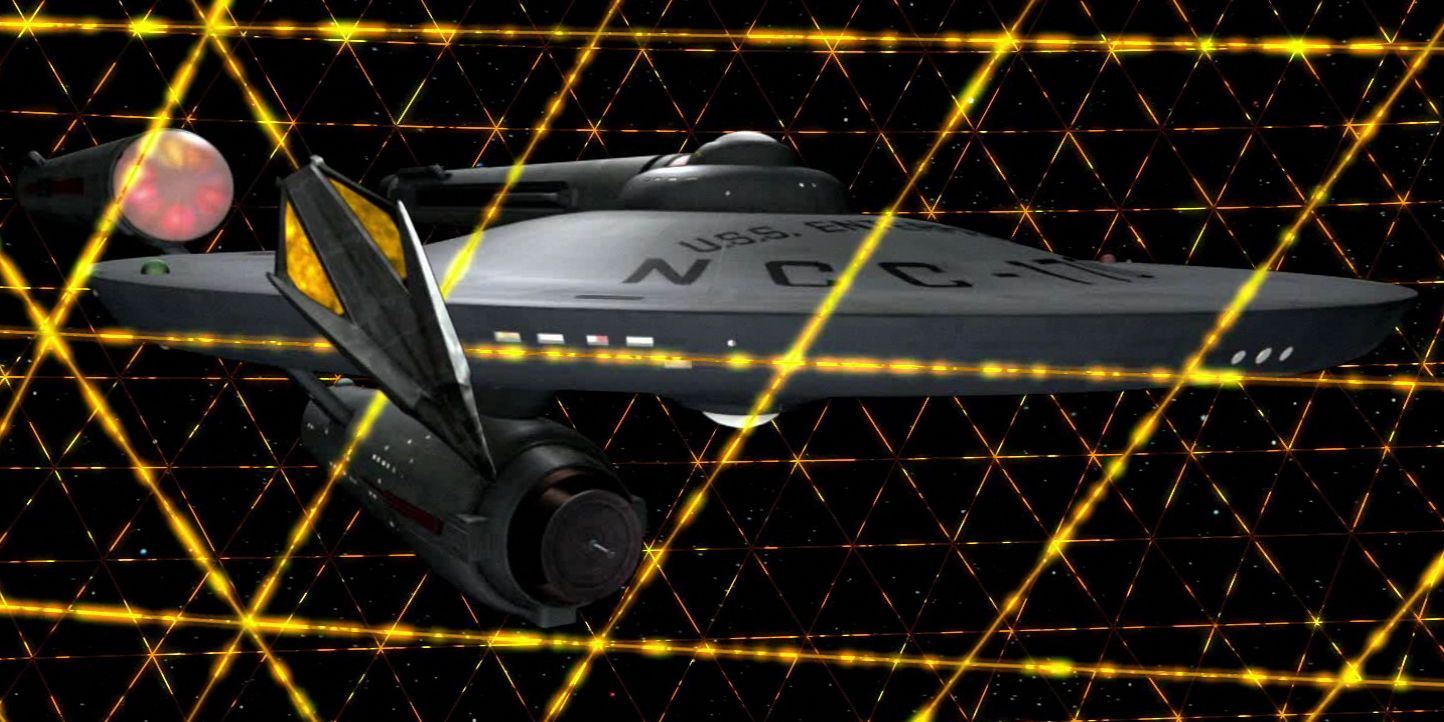Space, the final frontier. These are the voyages of the Starship Enterprise, the coolest bucket of bolts ever to sail the galaxy.
Yes, even more iconic than Captain Kirk himself is the beloved Constitution-Class exploration vessel, Enterprise, and its immediate successor, Enterprise-A. The first on-screen Enterprise made its debut in the pilot for Star Trek in 1966, and variants of the ship's design have been part of practically every subsequent production in the franchise.
The Enterprise will next be seen later this month in Star Trek Beyond, which will celebrate the 50th anniversary of the franchise, so let's take a look back at one of the most iconic space ships in science fiction history, which shuttled brave explorers from the safety of Earth to "where no man has gone before." We'll feature a variety of fun facts about Enterprise, both from within Star Trek lore to behind-the-scenes curiosities. Here are 15 Things You Need To Know About The Starship Enterprise.
15. It Was Designed By Matt Jefferies
Way back when Star Trek was just a dream in Gene Roddenberry's eccentric-genius mind, Matt Jefferies was hired to design the ship, Yorktown, which would eventually be re-named Enterprise, after the real-life high-profile Aircraft Carrier of the time.
Jefferies served in the United States Airforce and spent time inside various bombers during World War II. A skilled engineer and aviation scholar, Jefferies used his expertise to design the Enterprise, inside and out, with an "aircraft logic" that would make the television series more belivable to viewers. This approach led to Enterprise's smooth surface, devoid of the "kit-bashing" aesthetic present in so many science-fiction programs. Jefferies reasoned that all of the important equipment should be on the inside of the ship, rather than the outside. Imagine if, every time something went wrong on the ship, crew members would have to go outside to fix it, like when they work on the deflector dish in First Contact. One can see how that would be a pain in the butt, especially for the show's budget!
Jefferies's work on the interior of the ship, particularly the bridge, led to his designs being adapted for use on real naval vessels, and the man himself was hired by the US Navy.
14. It Can Break In Two, In Case Of Emergency
One of the lesser-known capabilities of the Enterprise is her ability to, in an emergency situation, jettison the back half of the ship. Called a "saucer separation," it was considered a last-resort move on Constitution-Class ships to escape unwanted orbit and protect the crew. However, without its warp nacelles (the two tubes located above the main body of the ship, behind the saucer), Enterprise would only be able to travel at impulse speed, which isn't very fast at all; only about one fourth the speed of light.
While a saucer separation was never seen in the original series or its accompanying movies, such a maneuver did occur in Star Trek: The Next Generation with the Enterprise-D, a ship specifically designed to separate for tactical use in battle. However, due to behind-the-scenes budget constraints, the Galaxy-Class ship didn't separate as often as was conceptually intended.
Interestingly, the saucer section of James Kirk's Enterprise looks suspiciously like traditional depictions of UFOs. We can't help but wonder if that design was intentional, perhaps for a time travel story in which Enterprise would have to separate and travel back in time, where it would be mistaken for an alien spacecraft? If there's a fan fiction story with this very scenario, let us know in the comments!
13.Weaponry
The Enterprise was designed to be an exploration vessel, built for years in deep space, and, while more than capable of engaging in battle when the need arose, it's decidedly not a warship. Enterprise was stocked with multiple photon torpedo launchers and a multitude of phaser banks. In the episode, "A Piece of the Action," Enterprise's phasers are set to stun and instantaneously knock out a whole city block worth of Tommy Gun-toting thugs. In theory, a fully charged phaser bombardment from orbit could devastate an entire planet, given enough time.
When faced with ship-to-ship combat, however, the phasers could tear the wings off of a Klingon Bird of Prey, both literally and figuratively, though the preferred weapon against such targets was Enterprise's complement of photon torpedoes. When attempting to disable weapons systems or fire "warning shots" against an enemy ship, phasers were used; when the time for diplomacy has passed and the only course of action is the annihilation of the enemy, that's when Kirk would order the firing of torpedoes, which could obliterate almost any target.
12. Captains James Kirk, Christopher Pike, And Robert April
James Tiberius Kirk is the most celebrated captain of the Enterprise, but he was not the first. Canonically, Christopher Pike was captain before Kirk, in both the original timeline, and the altered, J..J Abrams timeline (dubbed the Kelvin timeline). Pike appeared in the original pilot of the show, as well as the excellent two-part story, "The Menagerie." He was played by Jeffrey Hunter (King of Kings, The Searchers) in the original pilot, and by Bruce Greenwood (Double Jeopardy, Capote) in the J.J. Abrams films.
Before Pike, however, there was another captain. When Gene Roddenberry was first conceptualizing Star Trek, the name he had for the captain was Robert April. Though the character eventually became Pike, the name stuck around, and the character appeared in an episode of Star Trek: The Animated Series, as captain of the Enterprise before Pike. In the J.J. Abrams series, Pike is the first captain of the Enterprise, as the ship launches much later than in the original timeline, but Robert T. April makes a canonical appearance in "Countdown to Darkness", the comic book prequel to Star Trek Into Darkness. In it, he describes himself as the "former captain of a ship called Enterprise." Not "the" Enterprise, but "an" Enterprise. Fair enough.
11. Other Ships Called Enterprise
Little is known of Captain April's Enterprise from the Abrams-verse, but throughout the history of Starfleet, there have been many ships bearing the name Enterprise. In a bit of recursive canon, the "first" Enterprise was the 1970s space shuttle. Originally named Constitution, a letter-writing campaign and support from President Gerald Ford himself led to the shuttle being renamed Enterprise.
Next, there was an Enterprise which never made a formal appearance in any Star Trek media, but is shown in painting and model form in Star Trek: The Motion Picture and Star Trek Into Darkness, respectively, which was the very first Starship Enterprise, though comparatively little is known about it.
The first "famous" Enterprise was an NX-Class Starship captained by Jonathan Archer (Scott Bakula) in the final Trek series to date, Star Trek: Enterprise. The Enterprise-B appeared in Star Trek: Generations, and the Enterprise-C appeared in the Next Generation episode, "Yesterday's Enterprise." The Enterprise-D was the main setting of Star Trek: The Next Generation before being crashed (thanks, Deanna Troi). The absolutely gorgeous Enterprise-E became the main setting for the remainder of the Next Generation films. Lastly, an episode of Star Trek: Enterprise shows an alternate future where the Enterprise-J operates in the 26th Century. That's a lot of Enterprises. It remains to be seen if the new television series, slated to premiere in January 2017, will feature an Enterprise or a different ship, but we can't wait to see it.
10. The Classic Enterprise Design Almost Didn't Appear In Star Trek: The Motion Picture
Before Star Trek became a cultural phenomenon, a science fiction version of melting pot Americana, it was just a low-budget television show that got cancelled after only three seasons. It wasn't until reruns led to fan conventions and renewed interest (which included the short-lived Star Trek: The Animated Series) that Paramount decided to take another chance on the premise. A pair of film ideas failed to pan out, and the project eventually became Star Trek: Phase II, which would have documented a second five-year mission aboard a new Enterprise. The entire cast (minus Leonard Nimoy as Spock) were on board, and Enterprise went through a series of radical redesigns before returning to the iconic shape of the original ship.
Eventually, the project became a movie (again), Nimoy agreed to reprise his role, and the pilot episode of Phase II, "In Thy Image", was radically expanded into the script for Star Trek: The Motion Picture, a dense and cerebral science fiction story which polarizes fans to this day, with some praising its thought-provoking mysterious plot, while others decrying its slow pace and drab production design.
9. Refits and Upgrades
For its appearance in Star Trek: The Motion Picture, they couldn't just use the model from the original television series. Styles changed from the '60s to the '70s, and it just wouldn't look cinematic enough on the big screen. Rather than redesigning the familiar silhouette of Enterprise, the film's art designers merely updated the ship, modernizing it to contemporary audiences, just like Industrial Light & Magic would do for the 2009 reboot film.
In-universe, the changes in the ship were described as part of a total refit of Enterprise. After all, by this point in the timeline, she was a decades-old ship that had been through hell and back multiple times. The myriad changes to the ship lead to a unique dynamic between old warhorse Kirk (now an Admiral) and Captain Willard Decker, who is more familiar with Enterprise's modern configuration. This theme of old and young would be further explored in Star Trek II: The Wrath of Khan, in which Kirk's age and undeniable streak of luck inevitably catch up with him...
8. It Became A Training Ship
At the outset of The Wrath of Khan, Enterprise is out of active service, serving as a training vessel for new recruits. Despite its numerous improvements, as seen in The Motion Picture, Starfleet is working on bigger and better things (The Excelsior), and the old Constitution-Class Starship just can't keep up. Like his old ship, Kirk himself feels obsolete, captaining a desk rather than a space cruiser, waiting until his middle-age grows into being just plain old. Eventually, an old nemesis shows up to crash Kirk's would-be retirement, leaving Kirk and his ship no choice but to try and cheat death once more, though this time it comes at a greater cost than Kirk was ever willing to pay...
Enterprise may have been old, but she was a great ship, and using her as a training vessel may have been, to quote Spock, "A waste of material," but there's no denying that, once your time is up, the only thing one can do is to lie down and surrender to fate... Or is it?
7. That One Time It Exploded
By Star Trek III: The Search For Spock, Kirk is old, Enterprise is outclassed by the new Excelsior-Class Starship, and Spock is dead. But rather than accepting this, Kirk leads his crew on one last adventure to save his friend from the clutches of death itself. The quest, once again, costs Kirk more than he ever thought he would be forced to lose: his son, David, and his ship. Indeed, Kirk, at the film's darkest hour, programs Enterprise to self-destruct in an effort to give our heroes a chance to turn the tides and save the day. Dr. McCoy philosophizes, "You did what you always do. Turned death into a fighting chance for life."
The Enterprise self-destruct sequence is voice activated by the captain and two senior officers. Interestingly enough, the codes used are the exact same ones from the Season 3 episode, "Let That Be Your Last Battlefield." One would think that the passwords for destroying the ship might need to be reset more than once every twenty years, but that is apparently not the case for Starfleet.
6. Engineering in Space: Matter, Anti-Matter, and Dilithium Crystals
Star Trek, while a sci-fi fantasy series with exotic aliens and made-up lingo, has always followed its own internal logic. This dedication to its own aesthetics and physics is what has allowed the series to withstand scrutiny from scientists, and for its technology to seamlessly evolve across its centuries-long timeline.
In Star Trek, Dilithium crystals are rarer than diamonds, and are a key component in the formula for warp speed travel. Matter and Anti-Matter, combined with the Dilithium, creates the "fuel" required to generate warp. This "fuel" is probably the most dangerous substance in the universe, akin to the a nuclear reactor on a space-traveling scale. In space battles, a direct hit on the warp core generally causes the injured to ship to explode dramatically -- to the tune of a 97 megaton blast.
Hardcore fans can track the evolution of warp technology, from the huge amount of space required in Star Trek: Enterprise, to the relatively crude crystals in The Original Series, to the much sleeker designs in The Next Generation and beyond, increasing the efficiency of Dilithium crystals and thereby making the Federation a less energy-dependent organization.
5. Massive Size Differences In The Reboot
Calling JJ Abrams's Star Trek films the "reboot series" is kind of a misnomer. They're actually sequels, set in an alternate timeline where Starfleet technology developed differently following the unforeseen attack on the USS Kelvin on the day of James Kirk's birth. It's got elements of being a sequel, a prequel, and a reboot, all at once.
The updated design of Enterprise is immediately noticeable, though the epic change in the size of the Starship is less obvious to the untrained eye, or even longtime fans. Kirk's original Enterprise, first launched in 2245, was almost one thousand feet long and carried a crew of about four hundred people. In the altered timeline, Enterprise didn't embark on its maiden voyage until 2258, a full thirteen years after its counterpart, and was larger. Much larger. Chris Pine's Enterprise is nearly 2400 feet long, nearly two and a half times larger than the original version of the ship, and even larger than the Sovereign-Class, of which Picard's Enterprise-E was a leading example.
Overall, the design of the "reboot" Enterprise is still very much inspired by the classic original, but with a significantly glossier interior, more offensive capabilities, and, of course, more lens flares.
4. It Was Almost Upside-Down
When doing a feature on the original Star Trek back in the 1960s, TV Guide included a photo of Enterprise in all her glory. There was only one problem: the photo they used was upside down. The unique design of the ship, with its warp nacelles and flying saucer-esque disk shape up front, caused confusion among many who saw it and wound up seeing things with different perspectives, so to speak. There are numerous stories about Enterprise models being hanged upside down, drawn upside down, and causing headaches for everyone involved.
Even after Star Trek became a cultural phenomenon, problems with inverted blueprints persisted. The USS Reliant, as seen in Star Trek II, is upside down within the film! Actually, the legend goes that Reliant's nacelles were, like Enterprise, supposed to be above the saucer, but that they were approved by producer Harve Bennett, who wrote his signature... At the top of the paper... Upside down. The production designers decided that they liked it better that way than the way it was originally intended, and the Miranda-Class science vessel was born.
3. It Had Recreation Centers
Life on a spaceship is probably incredibly stressful, akin to life on a submarine. Fear of explosive decompression has probably kept many a seaman awake at night, and that tension must be immeasurably worse in the deep emptiness of space. Naturally, a crew would need something to take the edge off... And we're not talking about Romulan Ale, which is illegal.
Kirk's Enterprise had no less than six recreation rooms, wherein the captain often battled Spock at esoteric three-dimensional chess games. Enterprise also had a bowling alley, though this was never seen in the show... But William Shatner went on to compete in Celebrity Bowling in the 1970s, which makes such an establishment on the Enterprise something of a recursive inside joke. In Star Trek: The Motion Picture, Enterprise appears to be equipped with facilities resembling a videogame arcade.
It wasn't until the Enterprise-D and its legendary Holodeck that recreation in space really took off. While surely a lot of fun, the safeties were always getting accidentally deactivated, leading to so many headaches and deaths for Picard and his crew. "Death by Holodeck Malfunction" has to be the most embarrassing way to die in Starfleet.
2. It Was Decommissioned
All good things must come to an end, and Star Trek VI: The Undiscovered Country ends with a transmission from Starfleet, asking Kirk and his crew to bring Enterprise back to base for good, as the ship is scheduled to be retired. William Shatner's acting in the final scene of Star Trek VI is a thing of wonder, as his eyes well up with tears when he realizes, yes, it's actually over this time.
Of course, Shatner went on to star in one more film, Star Trek: Generations, which completely wasted his character, in more ways than one. As for the Enterprise, it was sent to a museum to be used in Kobayashi Maru-style wargames. However, legends never die, and William Shatner co-wrote the novel, The Ashes of Eden, in which, just prior to the opening of Star Trek: Generations, James Kirk pulls the ship out of mothballs for one last battle, ending in her destruction. Heroes die in battle, and the same goes for the Enterprise.
The canon statutes of The Ashes of Eden, as well as the other "Shatnerverse" (as they are called) novels is dubious at best, but given the choice, we'll gladly accept Enterprise-A going out in a blaze of glory, as well as Kirk's resurrection in The Return, a far better fate than his anti-climactic death in Star Trek: Generations. Really? Who gets killed by Malcolm McDowell in 1994? We could accept A Clockwork Orange McDowell, but not cantankerous old guy McDowell.
1. The Most Legendary Ship In Starfleet History
There's no doubt about it, Enterprise is the most celebrated ship in the history of Starfleet, and Captain Kirk is one of the most legendary men ever to wear a Starfleet uniform. Before Kirk's Enterprise, different exploratory vessels all used different insignia. After Kirk's five-year mission, all of Starfleet adopted Enterprise's mark, which became the de facto logo for Starfleet, to say nothing of the multitude of ships that carried the name Enterprise after the decommissioning of the Enterprise-A.
The fandom for Kirk and his ship is alive and well a hundred years later. In the Deep Space Nine episode, "Trials and Tribble-ations," Captain Sisko of DS9 totally geeks out when given the chance to meet the legend himself, James T. Kirk, and even risks serious charges from the Department of Temporal Investigations. It's a great episode which even includes an exploding Tribble, so there's something for every kind of Star Trek fan.
---
Are you excited to see the Enterprise in action in Star Trek Beyond? What do you love about this iconic ship? Sound off in the comments!

